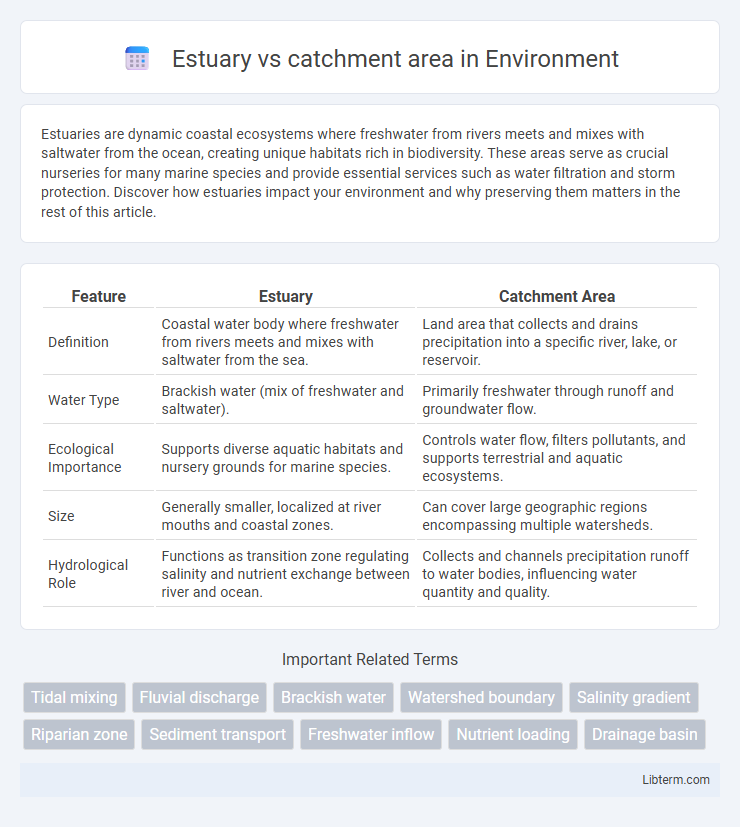Estuaries are dynamic coastal ecosystems where freshwater from rivers meets and mixes with saltwater from the ocean, creating unique habitats rich in biodiversity. These areas serve as crucial nurseries for many marine species and provide essential services such as water filtration and storm protection. Discover how estuaries impact your environment and why preserving them matters in the rest of this article.
Table of Comparison
| Feature | Estuary | Catchment Area |
|---|---|---|
| Definition | Coastal water body where freshwater from rivers meets and mixes with saltwater from the sea. | Land area that collects and drains precipitation into a specific river, lake, or reservoir. |
| Water Type | Brackish water (mix of freshwater and saltwater). | Primarily freshwater through runoff and groundwater flow. |
| Ecological Importance | Supports diverse aquatic habitats and nursery grounds for marine species. | Controls water flow, filters pollutants, and supports terrestrial and aquatic ecosystems. |
| Size | Generally smaller, localized at river mouths and coastal zones. | Can cover large geographic regions encompassing multiple watersheds. |
| Hydrological Role | Functions as transition zone regulating salinity and nutrient exchange between river and ocean. | Collects and channels precipitation runoff to water bodies, influencing water quantity and quality. |
Understanding Estuaries: Definition and Characteristics
Estuaries are dynamic coastal water bodies where freshwater from rivers meets and mixes with saltwater from the ocean, creating unique brackish environments rich in biodiversity and nutrient cycles. Catchment areas, or drainage basins, channel precipitation and surface runoff into rivers and streams, ultimately feeding water flow into estuaries and influencing their ecological health and sediment input. Understanding estuaries involves recognizing their role as transition zones with fluctuating salinity levels, tidal influences, and habitats critical for fish spawning, migratory birds, and mangrove ecosystems.
What is a Catchment Area? Key Features Explained
A catchment area, also known as a drainage basin, is the geographical region from which all precipitation collects and drains into a common outlet such as a river, lake, or estuary. Key features include defined boundaries formed by topographic high points, a network of tributaries channeling water flow, and the role it plays in directing surface runoff and groundwater recharge. This area is essential for water resource management, flood control, and ecosystem sustainability.
Geographical Differences Between Estuaries and Catchment Areas
Estuaries are coastal water bodies where freshwater from rivers mixes with seawater, forming unique brackish environments influenced by tidal patterns and saline gradients. Catchment areas, also known as drainage basins, are land regions where precipitation collects and drains into a common outlet, such as a river, lake, or estuary, encompassing diverse topographies and land uses. The key geographical difference lies in estuaries being transitional aquatic zones at river-sea interfaces, whereas catchment areas are extensive terrestrial landscapes defining the hydrological boundaries for water flow toward these aquatic systems.
Hydrological Processes in Estuaries vs Catchment Areas
Estuaries exhibit complex hydrological processes characterized by tidal mixing, saltwater-freshwater interaction, and sediment deposition, which regulate nutrient cycling and habitat diversity. Catchment areas primarily function through surface runoff, infiltration, and groundwater flow, controlling water quantity and quality entering rivers and streams. The dynamic exchange in estuaries contrasts with catchments' role in collecting and channeling precipitation through terrestrial landscapes to downstream aquatic systems.
Biodiversity and Ecosystems: Estuaries vs Catchment Areas
Estuaries serve as critical transitional zones where freshwater from catchment areas meets and mixes with seawater, supporting highly diverse and productive ecosystems that sustain numerous fish, bird, and plant species. Catchment areas contribute to estuary health by supplying nutrients, sediments, and freshwater essential for maintaining habitat complexity and water quality. Both estuaries and their upstream catchment areas are vital for preserving regional biodiversity and enabling ecosystem services like nutrient cycling, flood regulation, and habitat connectivity.
Human Impact on Estuaries and Catchment Areas
Human activities in estuaries and catchment areas significantly alter water quality and biodiversity. Urbanization, agriculture, and industrial discharge increase nutrient loading, causing eutrophication and habitat degradation in estuaries and their upstream catchments. Effective management strategies targeting pollution control and land-use planning are crucial to mitigate the adverse impacts on these interconnected environments.
Ecological Functions: Comparing Roles in the Environment
Estuaries serve as critical ecological buffers where freshwater from rivers meets and mixes with saltwater from the ocean, supporting diverse biological communities and nutrient cycling. Catchment areas collect precipitation and channel it into rivers, lakes, or aquifers, influencing water quality and sediment transport to downstream ecosystems including estuaries. The interaction between catchment areas and estuaries is essential for maintaining habitat connectivity, regulating nutrient inputs, and sustaining fish breeding grounds vital for biodiversity.
Water Quality Management in Estuaries and Catchment Areas
Water quality management in estuaries requires monitoring nutrient loads, salinity gradients, and tidal flushing to prevent eutrophication and habitat degradation. Catchment areas contribute runoff containing sediments, pollutants, and agricultural chemicals that directly impact downstream estuarine water quality. Integrating watershed management practices with estuarine protection strategies improves overall ecosystem health and resilience against pollution sources.
Importance to Local Communities and Economies
Estuaries serve as critical nurseries for fish species and support diverse marine life, directly sustaining local fisheries and boosting tourism economies. Catchment areas regulate freshwater flow and water quality, ensuring reliable water supplies for agriculture, industry, and households, thus underpinning regional economic stability. Both estuaries and catchment areas are vital for flood control and habitat preservation, safeguarding community infrastructure and promoting resilient ecosystems.
Conservation Challenges and Strategies for Each System
Estuaries face conservation challenges such as nutrient pollution, habitat loss, and salinity changes, requiring strategies like restoring wetlands, regulating upstream discharges, and implementing buffer zones to maintain water quality and biodiversity. Catchment areas struggle with sedimentation, deforestation, and land-use changes that disrupt hydrological cycles; therefore, conservation efforts emphasize reforestation, sustainable agriculture practices, and erosion control to protect watershed health. Both systems benefit from integrated management approaches that coordinate land and water use planning to balance ecological integrity with human activities.
Estuary Infographic

 libterm.com
libterm.com